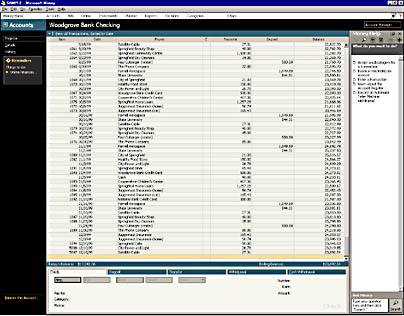Simplifying Windows
Users typically perform one task at a time. Why not put everything the user normally needs to perform the task in a single window? Web pages cannot have multiple windows, so there is no choice, but standard Windows programs can benefit from using a single window.
Of course, sometimes the user needs the power and flexibility provided by multiple windows. MDI programs such as Microsoft Word, Microsoft Excel, and Visual C++ need to provide this capability to users to help them accomplish their tasks since users often need to access multiple documents simultaneously. But the problem with MDI programs is that the power and flexibility provided by multiple windows has a cost—that cost is the added complexity of managing and viewing all those windows. MDI programs often have a significant amount of screen clutter. By contrast, single window programs require very little window management, as you only occasionally need to size the program window or move a window splitter. Your objective should be to give the single window the most useful layout by default so that the user doesn't have to change the layout just to perform a task.
Web pages use tables and frames to divide a single window into multiple regions. Frames are equivalent to splitter windows, and they are a good substitute for MDI in many situations. The home page used in Microsoft Money, shown previously, is a good example of a frame used in a standard Windows program. Programs such as Windows Explorer, Outlook, Microsoft FrontPage, and Encarta also use frames, and they work fine in a single window. Admittedly, frames have a bad reputation in Web design, but this is related more to the fact that some browsers don't handle frames well rather than to usability problems.
TIP
Don't use multiple windows when a single window will do. Try to have users perform a single task in a single window.
A small but visually significant difference between Web pages and standard Windows programs is that a Web page is a document. Normally, this means that all windows, by default, would have a white background. Standard windows programs tend to use a light gray background for each window that isn't a document window, such as dialog boxes, message boxes, and menus. Gray backgrounds help you create 3-D effects, but the trend is to use less 3-D because it has been terribly overused in the past. By using white backgrounds and fewer 3-D effects, you can give your windows a cleaner appearance, one that is easier to read and that has better contrast and focus. For example, this checking account window from Microsoft Money uses a light-colored background with the account information to make it easy to read and to focus the user's attention on the main task. Peripheral activities are given a dark background so that they will receive less attention.

TIP
Try to use more white backgrounds and fewer 3-D effects to give your windows a cleaner appearance.
EAN: 2147483647
Pages: 334